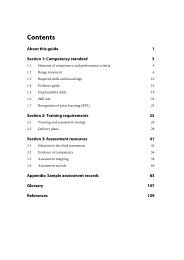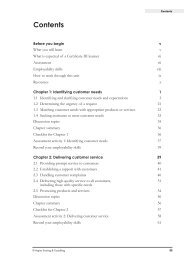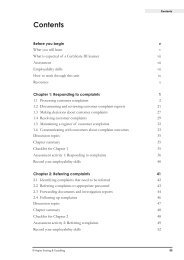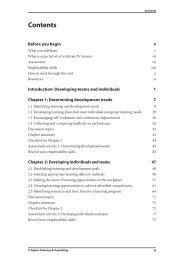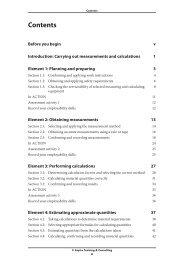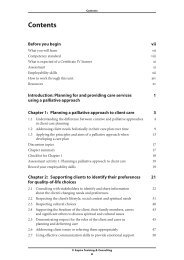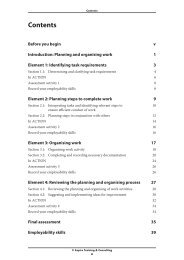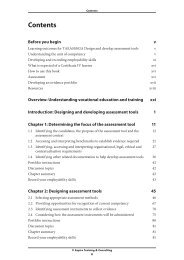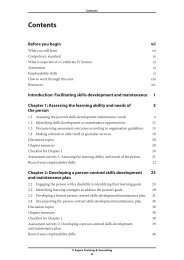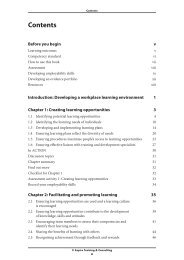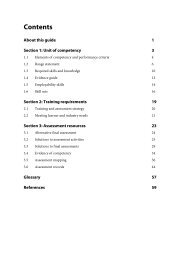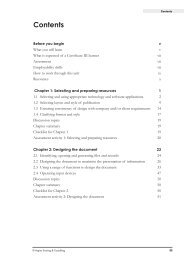BSBINM401A Implement workplace information system
BSBINM401A Implement workplace information system
BSBINM401A Implement workplace information system
You also want an ePaper? Increase the reach of your titles
YUMPU automatically turns print PDFs into web optimized ePapers that Google loves.
Before you begin<br />
Contents<br />
Before you begin<br />
What you will learn<br />
What is expected of a Certificate IV learner<br />
Assessment<br />
Employability skills<br />
How to work through this unit<br />
Resources<br />
v<br />
v<br />
vii<br />
vii<br />
vii<br />
ix<br />
x<br />
Introduction: <strong>Implement</strong> <strong>workplace</strong> <strong>information</strong> <strong>system</strong> 1<br />
Chapter 1: Identifying and sourcing <strong>information</strong> needs 3<br />
1.1 Determining and locating <strong>information</strong> 4<br />
1.2 Acquiring and reviewing the organisation’s <strong>information</strong> 15<br />
Discussion topics 25<br />
Chapter summary 25<br />
Checklist for Chapter 1 25<br />
Assessment activity 1: Identifying and sourcing <strong>information</strong> needs 26<br />
Record your employability skills 26<br />
Chapter 2: Collecting, analysing and reporting <strong>information</strong> 27<br />
2.1 Collecting <strong>information</strong> on time 28<br />
2.2 Ensuring <strong>information</strong> is in a suitable format 30<br />
2.3 Identifying and reporting on trends and developments 39<br />
Discussion topics 41<br />
Chapter summary 42<br />
Checklist for Chapter 2 42<br />
Assessment activity 2: Collecting, analysing and reporting <strong>information</strong> 43<br />
Record your employability skills 46<br />
Chapter 3: <strong>Implement</strong>ing <strong>information</strong> <strong>system</strong>s 47<br />
3.1 <strong>Implement</strong>ing effective management <strong>information</strong> <strong>system</strong>s 48<br />
3.2 Using technology effectively 51<br />
3.3 Recommending improvements to the <strong>information</strong> <strong>system</strong> 55<br />
Discussion topics 58<br />
Chapter summary 58<br />
© Aspire Training & Consulting<br />
iii
<strong>BSBINM401A</strong> <strong>Implement</strong> <strong>workplace</strong> <strong>information</strong> <strong>system</strong><br />
Checklist for Chapter 3 58<br />
Assessment activity 3: <strong>Implement</strong>ing <strong>information</strong> <strong>system</strong>s 59<br />
Record your employability skills 60<br />
Chapter 4: Preparing for <strong>information</strong> <strong>system</strong> changes 61<br />
4.1 Collecting <strong>information</strong> about future needs 62<br />
4.2 Ensuring estimates reflect the business plans and customer requirements 66<br />
4.3 Presenting appropriate submissions 69<br />
4.4 Preparing team members to work with changes to <strong>information</strong> <strong>system</strong>s 74<br />
Discussion topics 77<br />
Chapter summary 77<br />
Checklist for Chapter 4 78<br />
Assessment activity 4: Preparing for <strong>information</strong> <strong>system</strong> changes 79<br />
Record your employability skills 79<br />
Final assessment: <strong>BSBINM401A</strong> <strong>Implement</strong> <strong>workplace</strong> 81<br />
<strong>information</strong> <strong>system</strong><br />
Employability skills 83<br />
iv<br />
© Aspire Training & Consulting
Chapter 1: Identifying and sourcing <strong>information</strong> needs<br />
Chapter 1<br />
Identifying and sourcing <strong>information</strong><br />
needs<br />
Managers must understand the type of <strong>information</strong> needed by their team that will help<br />
them to carry out tasks to meet team objectives and organisational goals.<br />
Once the necessary <strong>information</strong> is identified, the manager needs to help team members<br />
find and access the <strong>information</strong>. Team members may need to be guided in analysing<br />
the <strong>information</strong> for accuracy and reliability, and assisted as they process and apply the<br />
<strong>information</strong>, to ensure it addresses the team’s needs.<br />
Managers need to undertake this process independently as they identify, locate, analyse<br />
and apply <strong>information</strong> to perform their duties and responsibilities in their role as<br />
manager.<br />
Identifying and sourcing <strong>information</strong> is the first step involved in implementing a<br />
<strong>workplace</strong> <strong>information</strong> <strong>system</strong>.<br />
In this chapter you will learn about:<br />
1.1 Determining and locating <strong>information</strong><br />
1.2 Acquiring and reviewing the organisation’s <strong>information</strong><br />
© Aspire Training & Consulting<br />
3
<strong>BSBINM401A</strong> <strong>Implement</strong> <strong>workplace</strong> <strong>information</strong> <strong>system</strong><br />
1.1 Determining and locating <strong>information</strong><br />
Information needs to be used and managed in different ways. As a manager, it is<br />
important that you use and circulate <strong>information</strong> appropriately, and that you guide your<br />
staff to do the same. For example, some <strong>information</strong> simply needs to be read by the<br />
appropriate people and then filed; other data needs to be further analysed and shared<br />
with others; some <strong>information</strong> needs to be continually referred to.<br />
Before you can do this, you need to be familiar with the range of <strong>information</strong> used<br />
by the organisation. The following table identifies different types of <strong>information</strong> and<br />
highlights characteristics that suggest the <strong>information</strong>’s intended purpose. As you read<br />
the list think of other examples in addition to those given.<br />
Example<br />
Type of<br />
<strong>information</strong><br />
Characteristics<br />
Examples<br />
Static Cannot be changed Tax file number, ABN, ACN<br />
Dynamic<br />
Easily manipulated, updated or<br />
changed<br />
Sales reports, employee contact<br />
details database, marketing data<br />
Recurring Created at regular intervals Operational plan, productivity<br />
report, annual report, financial<br />
data, continuous improvement and<br />
quality assurance data<br />
One-off<br />
Action needed<br />
No action<br />
required<br />
Internal<br />
External<br />
Created once for a unique event<br />
or need<br />
Requires staff to take some<br />
immediate action<br />
Informs staff but requires no action<br />
Information sourced within and<br />
generated by the organisation<br />
Information sourced and generated<br />
by a group or individual external<br />
to the organisation<br />
Project budget, organisation<br />
announcement<br />
Safety alert, security<br />
announcement<br />
New staff announcement, release<br />
of interim results<br />
Product announcement,<br />
departmental budget<br />
New OHS legislation, industry<br />
news, stationery price list<br />
Active Used frequently User manual, procedural<br />
documents<br />
Inactive Used infrequently Archived historical sales data,<br />
industry profile<br />
Formal<br />
Informal<br />
Recorded for use as a reference or<br />
communication tool<br />
Usually obtained through<br />
observation or verbal discussions<br />
Emails, memos, reports, files<br />
Conversations, observations of<br />
competitor or industry activity<br />
4<br />
© Aspire Training & Consulting
Chapter 1: Identifying and sourcing <strong>information</strong> needs<br />
Tips<br />
•<br />
•<br />
•<br />
•<br />
•<br />
•<br />
Make sure you and your team members are familiar where frequently used data is stored on<br />
your company’s server or intranet site. Ask your IT support staff to provide you with a map<br />
of what <strong>information</strong> is available and where it is located.<br />
Ensure your team members are aware of protocols for saving <strong>information</strong> they create onto<br />
servers or how to upload <strong>information</strong> to an intranet site. If this process is undertaken by<br />
individual staff within your organisation, make sure you and your team fully understand the<br />
process, the file formats needed and the request processes in place.<br />
When you set up your own filing <strong>system</strong>, electronic or paper-based, take time to think about<br />
how the <strong>information</strong> should be categorised – by subject, issue, creator or date There are<br />
many ways to set up filing <strong>system</strong>s – remember that the most important issue is being able<br />
to find the <strong>information</strong> you need quickly and simply. If your files are going to be accessed<br />
by a wide range of people, create a guide or reference <strong>system</strong> for them.<br />
If you are aware of ‘who knows what’ within your organisation, consider writing it down for<br />
your team members and other staff. Sometimes an individual’s title or department is not a<br />
clear indication of what they know or what they do on a day-to-day basis. This list could be<br />
a particularly valuable tool for new employees.<br />
When new documents are created by your team members, how do they name their files Do<br />
you find that files are created that can’t be found by others Consider establishing guidelines<br />
that help your team name and store files, especially if files are shared or used by more than<br />
one person. You could use a date-based <strong>system</strong>, where files are labelled by date and code<br />
relating to the content of the file and logged in a central location where all team members<br />
note down what they have created that day. You could also use longer file names that more<br />
fully reflect the content of the document. A common <strong>system</strong> within your team saves time.<br />
Remember to save revisions of documents correctly. Return <strong>information</strong> you take from a<br />
paper-based filing <strong>system</strong> to its correct place.<br />
Following organisational policies<br />
Ensure that <strong>information</strong> is collected in line with organisational policies and procedures<br />
or accepted actions.<br />
Your organisation’s standard operating procedures or other relevant guidelines need to<br />
be consulted to determine how to best access <strong>information</strong> held within the organisation.<br />
For example, your organisation may have a policy where sales and other financial data is<br />
restricted to certain people within the organisation, or particular operational plans are<br />
not shared with anyone other than directors or senior management.<br />
If your organisation does not have operating procedures or policies regarding the<br />
availability of <strong>information</strong> or you are not sure what protocols exist, your first step is to<br />
consult with your own manager about appropriate procedures.<br />
Although you may have to follow organisation policies and procedures in order to access<br />
some <strong>information</strong>, many organisations now recognise the value of shared <strong>information</strong><br />
and have developed <strong>system</strong>s that manage and facilitate <strong>information</strong> flow. Intranet sites,<br />
databases located on central servers and files that can be searched and accessed by wide<br />
groups of employees are effective ways to share and promote easy access to all sorts of<br />
<strong>information</strong>.<br />
© Aspire Training & Consulting<br />
17
Chapter 2: Collecting, analysing and reporting <strong>information</strong><br />
•<br />
•<br />
•<br />
•<br />
•<br />
•<br />
grouping, categorising or sorting <strong>information</strong> so that trends can be identified or key<br />
<strong>information</strong> can be quickly accessed<br />
bringing data together so it is in a similar format or standardised in some way<br />
making notes on or summarising <strong>information</strong> that you have already reviewed in a<br />
longer format<br />
using computer software (such as word processing, audiovisual presentation,<br />
spreadsheet, database or desktop design packages) to present data in appropriate<br />
and compatible ways<br />
following organisation-wide or team‐specific guidelines regarding the way<br />
<strong>information</strong> should be presented (such as a style guide or document templates)<br />
asking for advice from your manager as to how <strong>information</strong> should be presented.<br />
For example, after conducting an interview, you may need to record your handwritten<br />
notes in a logical format so that other team members can review the <strong>information</strong> and<br />
use it. The <strong>information</strong> should be typed so others can read it easily.<br />
Practice task 9<br />
1. What are some of the things you and your team do that help you, or others, to understand<br />
<strong>information</strong> you’ve gathered<br />
2. How do these activities help you to analyse and interpret the <strong>information</strong><br />
Preparing <strong>information</strong> for dissemination<br />
Once <strong>information</strong> has been prepared for analysis and interpretation, it might need<br />
to be disseminated for others to review and provide feedback or act on in some way.<br />
Alternatively, you may need to prepare a final report and disseminate it to appropriate<br />
personnel. Whatever the situation, here are some ways to help you do this efficiently.<br />
• Locate the addresses, either postal or email, to which <strong>information</strong> can be sent.<br />
• Determine the best way <strong>information</strong> should be disseminated depending on the<br />
audience and the type of <strong>information</strong> that needs to be sent out.<br />
• Ensure that confidential or sensitive <strong>information</strong> is disseminated in an appropriate<br />
manner.<br />
• Make sure that the intended audience can access the <strong>information</strong>.<br />
• Follow guidelines, restrictions or policies your team or organisation has in place<br />
regarding how <strong>information</strong> should be shared.<br />
• Make use of any address lists that have been created within your organisation, as<br />
appropriate.<br />
• Get approval, if necessary, to post <strong>information</strong> on intranet sites or electronic bulletin<br />
boards or on physical notice boards.<br />
Be aware of diverse audiences<br />
When communicating <strong>information</strong>, you need to consider that the people receiving the<br />
<strong>information</strong> will have different literacy skills. Literacy does not simply refer to a person’s<br />
reading level or familiarity with English. It also refers to financial, mathematical and<br />
technological literacy. Also, physical disability may mean that staff are unable to analyse<br />
<strong>information</strong> presented in certain ways.<br />
© Aspire Training & Consulting<br />
31
<strong>BSBINM401A</strong> <strong>Implement</strong> <strong>workplace</strong> <strong>information</strong> <strong>system</strong><br />
For example, people with hearing impairments may not be able to participate in team<br />
discussions or listen to verbal announcements. Others may have a disability that inhibits<br />
their ability to process <strong>information</strong>, or some may simply have a reduced reading ability<br />
or understanding of mathematics that means they can struggle to make sense of data.<br />
Modes of sharing <strong>information</strong><br />
Information can be disseminated in informal or formal ways. You need to consider<br />
who the recipients of the <strong>information</strong> will be and how they should receive data before<br />
deciding on an appropriate presentation. Following are some common methods of<br />
<strong>information</strong> sharing.<br />
Written <strong>information</strong><br />
Circulating written <strong>information</strong>, such as reports, memos or bulletins, has become<br />
less popular since the advent of email; however, in many <strong>workplace</strong>s it is still the<br />
most effective way to share <strong>information</strong> with staff. Posting brief announcements or<br />
bulletins on noticeboards, writing a letter or short report to staff and dropping copies<br />
into pigeonholes or circulating one copy using a circulation slip (such as the following<br />
example) are common and effective ways of sharing written <strong>information</strong>.<br />
Example<br />
FOR CIRCULATION<br />
Name Date received Date passed on<br />
Fatima Abdullah<br />
Josh Brady<br />
Maria Brunos<br />
Carla Mathison<br />
Tony McWilliams<br />
Troy Nguyen<br />
Mikki Santini<br />
Anna Stranovski<br />
Sheryl Tanner<br />
Carlos Vasquez<br />
To speed up the circulation of the attached,<br />
please:<br />
Read, review or photocopy the attached documents<br />
ASAP<br />
Pass on to the next listed person<br />
OR in that person’s absence, the next one<br />
Please return to<br />
32<br />
© Aspire Training & Consulting
Chapter 2: Collecting, analysing and reporting <strong>information</strong><br />
Assessment activity 2<br />
Collecting, analysing and reporting <strong>information</strong><br />
The following table maps the assessment activity for this chapter against the element and<br />
performance criteria of Element 2 in <strong>BSBINM401A</strong> <strong>Implement</strong> <strong>workplace</strong> <strong>information</strong><br />
<strong>system</strong>.The activity has been designed for all learners to complete.<br />
Part Element Performance criteria<br />
Whole activity 2 All<br />
Think about how you gather, analyse and disseminate <strong>information</strong> now, and how you<br />
might do this more effectively in future.<br />
Use the following headings to develop an <strong>information</strong> management plan. Use bullet<br />
points and numbers for your responses. You might like to prepare a table similar to the<br />
one on the following pages.<br />
1. Ensuring <strong>information</strong> collection is timely<br />
2. Checking that <strong>information</strong> meets your needs<br />
3. Bringing different <strong>information</strong> together<br />
4. Analysing <strong>information</strong><br />
5. Disseminating <strong>information</strong><br />
6. Identifying and reporting trends and developments in the <strong>information</strong><br />
© Aspire Training & Consulting<br />
43
Employability skills<br />
Employability skills<br />
In the table below, describe the activities you have undertaken that demonstrate how<br />
you developed the following employability skills as you worked through this unit. Keep<br />
copies of material you have prepared as further evidence of your skills.<br />
Alternatively, prepare a table similar to the following table.<br />
Employability skills<br />
Communication<br />
The activities undertaken to<br />
develop the employability skill<br />
Teamwork<br />
Planning and<br />
organising<br />
Initiative and<br />
enterprise<br />
Problem-solving<br />
Self-management<br />
Technology<br />
Learning<br />
© Aspire Training & Consulting<br />
83



